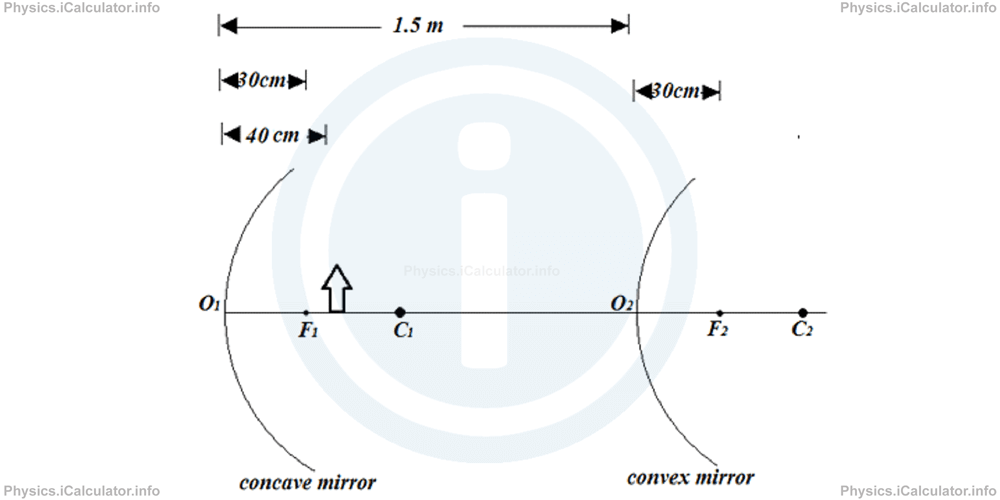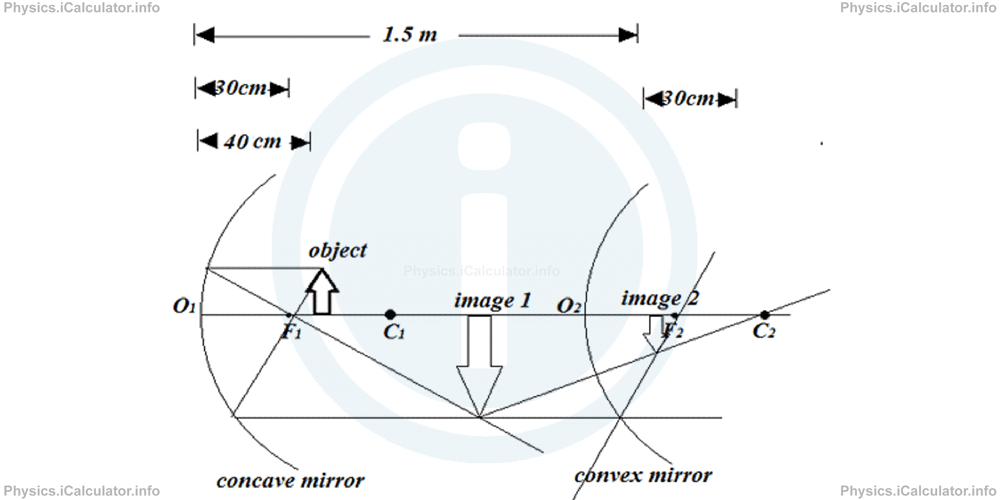Menu
Physics Lesson 12.8.8 - What If There Are More Than Two Curved Mirrors in the Same System?
Please provide a rating, it takes seconds and helps us to keep this resource free for all to use
Welcome to our Physics lesson on What If There Are More Than Two Curved Mirrors in the Same System?, this is the eighth lesson of our suite of physics lessons covering the topic of Mirrors. Equation of Curved Mirrors. Image Formation in Plane and Curved Mirrors, you can find links to the other lessons within this tutorial and access additional physics learning resources below this lesson.
What If There Are More Than Two Curved Mirrors in the Same System?
In this case, the calculations are performed by considering the mirrors one by one. This means the image produced by the first mirror acts like an object for the second mirror and so on. The rules are the same as for a single curved mirror.
Example 3
: An object is placed between two mirrors - one concave and the other convex - which are 1.5 m apart from each other. The object is 40 cm in front of the concave mirror. If both mirrors have the same focal length equal to 30 cm, calculate the position of the second image produced on the convex mirror (i.e. the image produced on the convex mirror when the image on the concave mirror is considered as object for the convex mirror).
Solution 3
First, let's determine the position of the image produced in the concave mirror in respect to it. We have the following clues:
F1 = 30 cm
dî = ?
We have:
1/40 + 1/dî = 1/30
1/dî = 1/30 - 1/40
= 4/120 - 3/120
= 1/120
Therefore, the image produced in the concave mirror is 120 cm away from it. This means this image - which acts as an object for the convex mirror - is 150 cm - 120 cm = 30 cm before the convex mirror.
Given that in convex mirrors the focus is negative, we have the following clues for the second reflection:
F2 = - 30 cm
dî = ?
We have:
1/30 + 1/dî= - 1/30
1/dî= - 1/30 - 1/30
= - 2/30
= - 1/15
Note: The fraction - 2/30 is simplified to - 1/15. Thus, the second image is produced 15 cm after the convex mirror. Look at the figure.

You have reached the end of Physics lesson 12.8.8 What If There Are More Than Two Curved Mirrors in the Same System?. There are 8 lessons in this physics tutorial covering Mirrors. Equation of Curved Mirrors. Image Formation in Plane and Curved Mirrors, you can access all the lessons from this tutorial below.
More Mirrors. Equation of Curved Mirrors. Image Formation in Plane and Curved Mirrors Lessons and Learning Resources
Whats next?
Enjoy the "What If There Are More Than Two Curved Mirrors in the Same System?" physics lesson? People who liked the "Mirrors. Equation of Curved Mirrors. Image Formation in Plane and Curved Mirrors lesson found the following resources useful:
- Multiple Feedback. Helps other - Leave a rating for this multiple (see below)
- Optics Physics tutorial: Mirrors. Equation of Curved Mirrors. Image Formation in Plane and Curved Mirrors. Read the Mirrors. Equation of Curved Mirrors. Image Formation in Plane and Curved Mirrors physics tutorial and build your physics knowledge of Optics
- Optics Revision Notes: Mirrors. Equation of Curved Mirrors. Image Formation in Plane and Curved Mirrors. Print the notes so you can revise the key points covered in the physics tutorial for Mirrors. Equation of Curved Mirrors. Image Formation in Plane and Curved Mirrors
- Optics Practice Questions: Mirrors. Equation of Curved Mirrors. Image Formation in Plane and Curved Mirrors. Test and improve your knowledge of Mirrors. Equation of Curved Mirrors. Image Formation in Plane and Curved Mirrors with example questins and answers
- Check your calculations for Optics questions with our excellent Optics calculators which contain full equations and calculations clearly displayed line by line. See the Optics Calculators by iCalculator™ below.
- Continuing learning optics - read our next physics tutorial: Lenses. Equation of Lenses. Image Formation of Lenses
Help others Learning Physics just like you
Please provide a rating, it takes seconds and helps us to keep this resource free for all to use
We hope you found this Physics lesson "Mirrors. Equation of Curved Mirrors. Image Formation in Plane and Curved Mirrors" useful. If you did it would be great if you could spare the time to rate this physics lesson (simply click on the number of stars that match your assessment of this physics learning aide) and/or share on social media, this helps us identify popular tutorials and calculators and expand our free learning resources to support our users around the world have free access to expand their knowledge of physics and other disciplines.